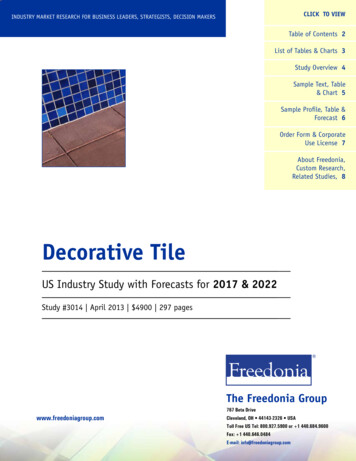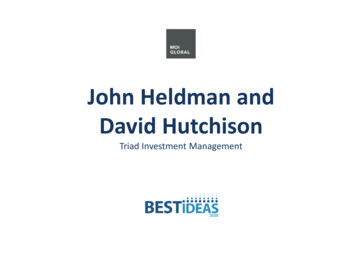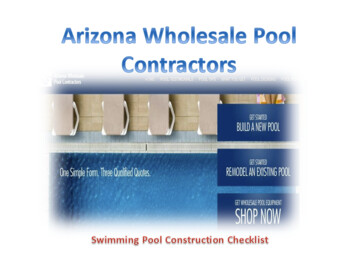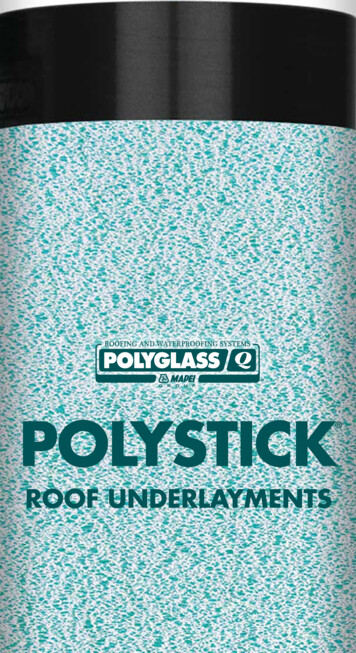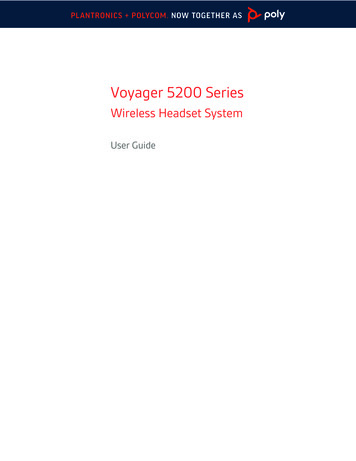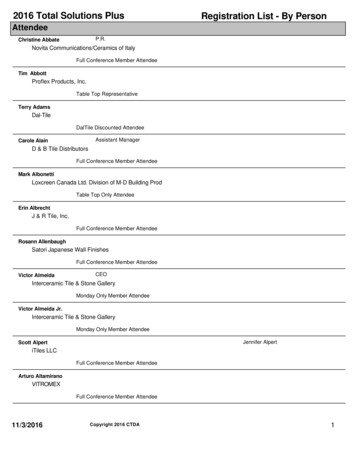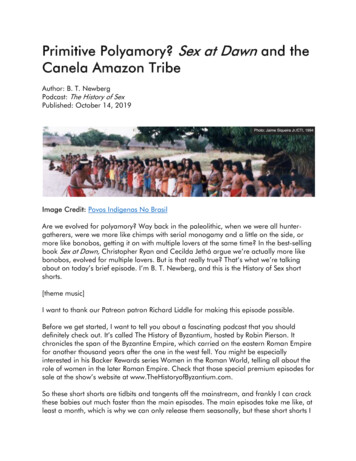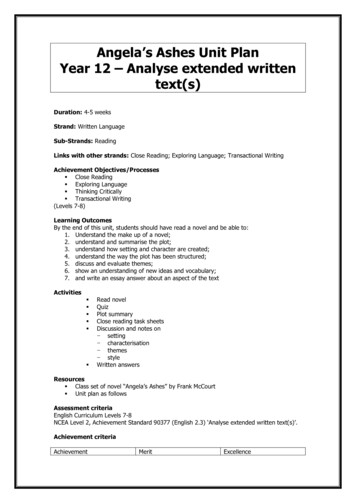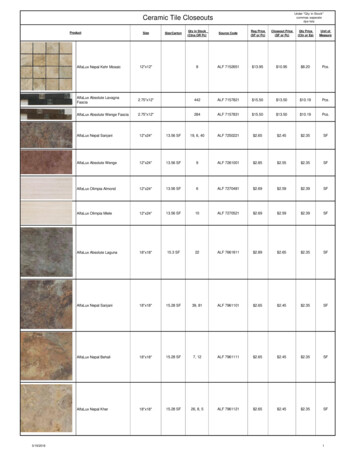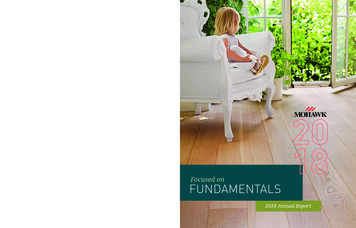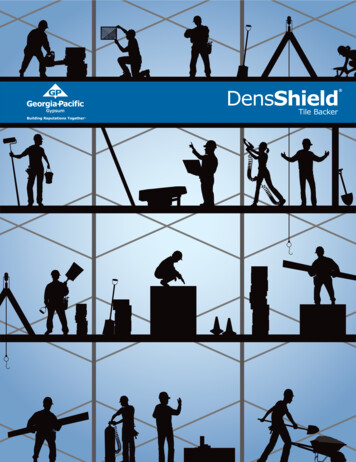
Transcription
DensShieldTile Backer
DensShield Tile BackerProduct OverviewCoated Fiberglass MatBuilt-in AcrylicCoatingMoisture-ResistantGypsum CoreDensShield Tile Backer 2013 Georgia-Pacific Gypsum LLCTable of ContentsProduct Overview. . . . . . . . . . . . . . . .2Physical Properties. . . . . . . . . . . . . . .3Fastener Guide. . . . . . . . . . . . . . . . . .3Testing and Code Recognition. . . . . .4Architectural Specifications . . . . . . .5Tub/Shower Wallsor Ceilings . . . . . . . . . . . . . . . . . . . . .6Residential and LightCommercial Floors . . . . . . . . . . . . . . .9Countertops . . . . . . . . . . . . . . . . . . .10Showers . . . . . . . . . . . . . . . . . . . . . .10Non-Tile Walls or Ceilings . . . . . . .11High-HumidityNon-Tile Areas. . . . . . . . . . . . . . . . .11Wet Non-Tile Areas. . . . . . . . . . . . .11Residential Steam Rooms . . . . . . . .12Waterproofing SystemExamples . . . . . . . . . . . . . . . . . . . . .13Fire-Rated Assemblies. . . . . . . . . . .14DensShield Tile Backer is designed for use as a tile substrate for walls, ceilings, floorsand countertops. DensShield is an ideal tile backer board for high moisture areas becauseit has a built-in moisture barrier that stops moisture at the surface. This special coatinghelps protect the tile installation and wall cavity from moisture intrusion. DensShieldpanels are mold resistant, and have scored a 10, the highest level of performance formold resistance under the ASTM D 3273 test method.* Treated, water-resistant core. Fiberglass mats on front and back add strength. Grey, heat-cured acrylic coating helps protect the tile installation and wall cavityfrom moisture intrusion and damage. The first tile backer in the industry with a built-in moisture barrier and a waterresistant treated core.DensShield Tile Backer is the first tile backer listed as a GREENGUARD microbialresistant product by a leading third-party organization, GREENGUARD EnvironmentalInstitute. This listing means DensShield Tile Backer, which features fiberglass matsinstead of the paper facings used on the surface of traditional tile backers, resistsmold growth. The microbial-resistant test is based on ASTM Standard D 6329, atesting standard set by ASTM International, which develops testing guidelines andprocedures for building materials, products, systems and services.*See Mold Resistance Test on page 4.Delivery, Handlingand Storage . . . . . . . . . . . . . . . . . . .152 For latest information and updates:Technical Service Hotline 1.800.225.6119 or www.gpgypsum.comCAUTION: For product fire, safety and use information,go to gp.com/safetyinfo.
DensShield Tile BackerPhysical PropertiesPropertiesWidth, standard31/4” 6.4 mm)DensShield 4’ (1220 mm)Length, standard34’ (1220 mm)EdgesWeight1 nominal, lbs./sq. ft. (Kg/m2)Bending Radius4Fire Classificationsquare1.6 (7.8)8’ (2438 mm)n/a1/2” (12.7 mm)DensShield 4’ (1220 mm),32” (813 mm)5’ (1524 mm)8’ (2438 mm)square2.0 (9.8)12’ (3658 mm)n/aPermeance5, perms (ng/Pa s m2)R Value2, ft2 F hr/BTU(m2 K/W)StandardsCode Evaluation 1.5 (86) 1.5 (86)TCNA Recognition5/8” (15.9 mm)DensShield Fireguard 4’ (1220 mm)8’ (2438 mm)square2.5 (12.2)16’ (4877 mm)Type X (ASTM C 1178),UL and ULC classified* 1.5 (86)0.56 (0.098)0.56 (0.098)0.67 (0.118)ASTM C 1178ASTM C 1178ASTM C 1178DensShield is manufactured to meet ASTM C 1178 and is accepted for use as a tilebacker in tub and shower areas in accordance with current IBC and IRC codes.NY MEA 65-88-M, ICC-ES product approvalASTM C 627 (Robinson Floor Test); Floors – F146, F151; Radiant Floor – RH135;Walls – W221, W222, W223, W242, W243, W245; Ceilings – C311, C312, C315;Tubs – B413, B419; Showers – B420; Countertop – C513* Consult the UL and ULC Directories for approved use.1Represents approximate weight for design and shipping purposes.2Tested in accordance with ASTM C 518.3Specified values per ASTM C 1178.4Double fasteners on ends as needed.5Tested in accordance with ASTM E96 (drycup method). Perm rating for DensShield only. Tile applications will have lower perm.Fastener GuideApplicationFastenerMin. Length1/2” (13 mm) / 5/8” (16 mm)SpacingWalls & CeilingsGalvanized* roofing nail6” (152 mm) o.c. along framingWalls & Ceilings(wood frame)Walls & Ceilings(steel frame)FloorsBuglehead, rust resistant*, coarsethread, sharp point screwBuglehead, fine thread, sharp pointrust resistant* drywall screwGalvanized* roofing nail1-1/2” (38 mm)1-3/4” (45 mm)1-1/4” (32 mm)1-5/8” (41 mm)1-1/4” (32 mm)1-1/4” (32 mm)FloorsBuglehead, corrosion resistant*,coarse thread, sharp point screw1/4” (6 mm) crown, corrosiveresistant* chisel point staples8” (203 mm) o.c.in both directions8” (203 mm) o.c.in both directions2” (51 mm) o.c. on edges4” (102 mm) o.c. in fieldFloors (1/4” only)(6.4 mm only)1-1/4” (32 mm)7/8” (22 mm)6” (152 mm) o.c. along framing6” (152 mm) o.c. along framingNote: For walls, fasteners should penetrate at least 3/4” (19 mm) into the wood framing.*Contact fastener manufacturer for proper selection of corrosion resistance.CAUTION: For product fire, safety and use information,go to gp.com/safetyinfo.For latest information and updates:Technical Service Hotline 1.800.225.6119 or www.gpgypsum.com3
DensShield Tile BackerTesting and Code RecognitionRobinson Floor Test/ASTM C 627 – DensShield Tile Backer has passed the industry standard test conducted by the TileCouncil of North America for residential and light commercial floors.Adhesion Bond Testing – CTC-Geotek conducted tests comparing adhesion capabilities using various setting materials. Thetests concluded that bonds with DensShield Tile Backer were as good, if not better, than bonds with cement board.Shower Test – In a test by an independent testing laboratory, DensShield Tile Backer was subjected to a shower of water at110 F (43.3 C), 12 minutes per hour, 24 hours a day, 7 days a week for six months. The installation had no grout between thetiles. No deterioration occurred to either the DensShield backer board, the framing members or the wall cavity.The DensShield Tile Backer test was designed to represent 12 years of regular shower use. Although cementitiousbacker boards would not likely deteriorate under the same conditions, the possibility exists for deterioration offraming members and the wall cavity due to water infiltration if a moisture barrier isn’t positioned behind thecementitious backer unit.Percolation Test – The percolation test helps determine if an additional moisture barrier should be installed. The test consistsof a 2” (51 mm) diameter tube, 48” (1220 mm) long, bonded to test samples with silicone sealant. The tube is filled with waterand after 48 hours, the remaining water is measured (minus evaporation).During testing 1/8” (3 mm) of water passed through DensShield Tile Backer, 19” (483 mm) of water passed through one cementitioustile substrate sample and 43” (1092 mm) of water passed through another sample of cement board. The test demonstratesDensShield Tile Backer stops water at the surface, while cement boards allow water to pass through their porousconstruction. The Tile Council of North America requires the use of a membrane in wet areas for cement backer boards butdoes not require a membrane for DensShield Tile Backer since DensShield panels have a built-in moisture barrier that stopsmoisture at the surface.Water Vapor Transmission – ASTM E96 test method intends to measure the rate of water movement through a material’ssurface over a period of time. This is accomplished under controlled conditions of temperature and humidity. It is used to assessthe passage of water vapor through paper, plastic films, other sheet materials, fiberboards, wood products, gypsum andplaster products.Mold Resistance Test – When tested, as manufactured, in accordance with ASTM D 3273, DensShield Tile Backer has scoreda 10, the highest level of performance for mold resistance under the ASTM D 3273 test method.The score of 10, in the ASTM D 3273 test, indicates no mold growth in a 4-week controlled laboratory test. The mold resistance ofany building product when used in actual job site conditions may not produce the same results as were achieved in the controlled,laboratory setting. No material can be considered mold proof. When properly used with good design, handling and constructionpractices, Dens Brand gypsum products provide increased mold resistance compared to standard paper-faced wallboard. For moreinformation, go to www.gp.com/safetyinfo.DensShield Tile Backer is the first tile backer listed as a GREENGUARD microbial-resistant product by a leading third-partyorganization, GREENGUARD Environmental Institute. This listing means DensShield Tile Backer, which features fiberglass matsinstead of the paper facings used on the surface of traditional gypsum tile backers, resists mold growth. The microbial resistanttest is based on ASTM Standard D 6329, a testing standard set by ASTM International, which develops testing guidelines andprocedures for building materials, products, systems and services.Standards and Code Compliance – DensShield Tile Backer in 1/4” (6.4 mm), 1/2” (12.7 mm) and 5/8” (15.9 mm) thicknessesconforms to current IRC and IBC codes and is manufactured to meet ASTM C 1178 as a fiberglass mat gypsum substrate for useas tile backer. DensShield Tile Backer has the following evaluation reports: ICC-ES product approval; New York City MEA 65-88-M.DensShield Tile Backer installation information is listed in the current Tile Council of North America (TCNA)Handbook for Ceramic Tile Installation.4 For latest information and updates:Technical Service Hotline 1.800.225.6119 or www.gpgypsum.comCAUTION: For product fire, safety and use information,go to gp.com/safetyinfo.
DensShield Tile BackerGeorgia-Pacific Gypsum and SustainabilityGeorgia-Pacific Gypsum’s definition of sustainability is meeting the needs of society today without jeopardizing our ability to do soin the future. We are committed to using resources efficiently to provide innovative products and solutions that meet the needs ofcustomers and society, while operating in a manner that is environmentally and socially responsible, and economically sound.We continue to focus on: Improving energy efficiency at our manufacturing plants Seeking out opportunities to reduce water use, and to reuse water more efficiently Finding cost effective ways to further reduce air emissions Recovering and reusing materials that otherwise would end up in landfills.Green building codes, standards, and programs are establishing themselves across the country. They promote the use of productsthat contribute to the performance of the building, along with minimizing environmental and human health impacts over the lifeof the building or home. Because we embrace product performance and operate in an environmentally, socially, and economicallysound manner, owners and architects can feel good about the structures they build using our products.Many of our products contribute to LEED and other green building codes, standards, or program credits or requirements. To findout more, please refer to the Sustainable Materials Data Sheets (SMDS) at www.gpgypsum.com for recycled content, regionalmaterials, and low emitting materials information or use our on-line LEED calculator to calculate contribution for a specific credit.For general information on sustainability, click the “Sustainability” tab on the website.Architectural SpecificationsGeorgia-Pacific Gypsum’s 3-part guide specifications are downloadable, as rewritable Microsoft Word documents, in bothCSI and ARCOM MasterSpec formats. Georgia-Pacific Gypsum specifications and 3-D Revit compatible models can befound at www.gp.com/toolbox. Downloadable specifications are also available online from Building Systems Design, Inc.at www.bsdsoftlink.com, and ARCOM Product Masterspec at www.masterspec.com.CAUTION: For product fire, safety and use information,go to gp.com/safetyinfo.For latest information and updates:Technical Service Hotline 1.800.225.6119 or www.gpgypsum.com5
DensShield Tile BackerTub/Shower Walls or CeilingsDS001 Walls or CeilingsDensShield Tile Backer can be used as a tile substrate in residential and commercial wall applications. Attach DensShieldTile Backer with grey side facing the interior. Tiles should always be applied to grey side. Cut panel to required size and makecutouts. Fit ends and edges closely. Do not leave gaps between panels.DensShield Tile Backer may be cut by using a utility knife to score, then snap, working from the grey face side.For walls, when used as a tile substrate a minimum 20-gauge* (33 mils) steel or wood framing should be spaced no greater than16” (406 mm) o.c. or 24” (610 mm) with blocking at all joints for 1/2” (12.7 mm) DensShield Tile Backer and 24” (610 mm) o.c. for5/8” (15.9 mm) DensShield Tile Backer. Board can be applied horizontally or vertically.For ceilings, framing should be spaced no greater than 12” (305 mm) o.c. for 1/2” (12.7 mm) or 16” (406 mm) o.c. for5/8” (15.9 mm) thickness. Board should be applied perpendicular to framing.Fasteners shall be spaced 6” (152 mm) o.c. for walls and ceilings for wood and steel framing. Do not countersink. Drive fastenersflush with grey coated surface. See Fastener Guide for proper selection.Do not use DensShield panels as a base for nailing and mechanical fastening.In all corners, imbed with a bead of flexible sealant when installing panels into corner. Apply self-adhesive 2” (51 mm) widefiberglass mesh tape and bed tape on all joints and corners with material used to set tiles (details on page 8).Caulk or seal fixture/plumbing penetrations and abutments to dissimilar materials.Do not use all-purpose joint compound or paper tape in wet areas.In areas outside the shower where DensShield Tile Backer meets gypsum board: (1) If the tiles fall over the DensShield TileBacker-to-gypsum board joint, apply 2” (51 mm) wide fiberglass mesh tape and skim with tile setting material (Type I masticANSI 136.1 or latex modified thin-set ANSI A118.4). (2) If the tiles stop before the DensShield Tile Backer-to-gypsum boardjoint, apply 2” (51 mm) wide fiberglass mesh tape and skim with setting type joint compound to achieve a smooth and paintablesurface. (3) For areas that will not be exposed directly to moisture, all-purpose joint compound may be used.Do not install vapor barriers directly behind DensShield panels. DensShield has a built-in moisture barrier; a #15 felt behind theDensShield is permissible if required by local code jurisdiction. Additional waterproofing systems may be installed over the faceof DensShield panels.Do not use DensShield as a radiant barrier behind fireplaces.Not for exterior use.Do not apply DensShield directly to concrete or masonry block.Framing or furring of the wall is necessary.AEEGA. DensShield Tile BackerB. Tile adhesiveC. TilesADD. Wood or minimum 20-gauge* (33 mils) steel framingE. Flexible sealant into min. 1/8” (3 mm) gapCBF. BathtubG. Fiberglass mesh tapeEF*For equivalent and effective gauge steel studs, wehave no evaluation or installation recommendations.6 For latest information and updates:Technical Service Hotline 1.800.225.6119 or www.gpgypsum.comCAUTION: For product fire, safety and use information,go to gp.com/safetyinfo.
DensShield Tile BackerDS002 Shower PanInstall DensShield Tile Backer on walls according to assembly DS001.Shower pan or rubber membrane must be adequately sloped to the open drain or weep-hole detail to permit properwater drainage.For showers with curbs, apply waterproof membrane up walls minimum 2” (51 mm) and maximum 4” (102 mm) above curb. Donot use DensShield Tile Backer in the curb.For showers without curbs, apply waterproof membrane up walls minimum 6” (152 mm) and maximum 8” (203 mm).Wood or other satisfactory blocking should be applied at the bottom framing to support the vertical sides of theshower pan or membrane and DensShield Tile Backer.Do not place DensShield Tile Backer into a conventional shower pan mortar bed. Leave minimum 1/8” (3 mm) gapand fill with flexible sealant.A. DensShield Tile BackerB. Flexible sealant into min. 1/8” (3 mm) gapC. TilesACD. Sloped rubber membraneE. Sloped mortar bedF. Crushed stoneFDAEG. Weep holesGBBDS003 Bathtub ReceptorApply DensShield Tile Backer either horizontally or vertically on walls as shown in DS001.To prevent water penetration, completely fill the space between tile and tub with a flexible sealant.To compensate for the tub flange, some contractors add a furring strip to the framing members.This enables them to hang the DensShield within 1/8” (3 mm) from the top of the tub.A. DensShield Tile BackerAB. TilesC. Tile adhesive (latex thinset mortar or mastic)D. Wood or minimum 20-gauge* (33 mils) steel studsBDCE. FastenerEF. Flexible sealant into min. 1/8” (3 mm) gapG. BathtubFH. Fireproofing when required (by other trades)GH*For equivalent and effective gauge steel studs, wehave no evaluation or installation recommendations.CAUTION: For product fire, safety and use information,go to gp.com/safetyinfo.For latest information and updates:Technical Service Hotline 1.800.225.6119 or www.gpgypsum.com7
DensShield Tile BackerDS004 Other DetailsApply DensShield Tile Backer either horizontally or vertically on walls as shown in DS001.To prevent water penetration, completely fill the space between tile and tub with a flexible sealant.A.B.C.D.E.F.G.H.I.K.L.1/2” (12.7 mm) or 5/8” (15.9 mm) DensShield Tile BackerTilesTile adhesive (latex thinset mortar or mastic)Flexible sealant into min. 1/8” (3 mm) gapShower panWaterproofing system*2 x 4 supports (slope seat 1/4” (6 mm) per foot toward drain)Modified dry-setPlywood (min. 1/2” (12.7 mm))Sloped concreteMembrane, max. 6” (152 mm) from floor or2” (51 mm) above thresholdM. Tile adhesive embedded in fiberglass mesh tapeN. Minimum 20 gauge** (33 mils) steel studsO. Flexible sealantABCDEAFFIHBAGBGSide view of shower seatNGDKnee wall detailsKLONMCorner detail with flexiblesealant and joint finishingAA*See table on page 13 for waterproofing system examples.**For equivalent and effective gauge steel studs, we have no evaluation or installation recommendations.8 For latest information and updates:Technical Service Hotline 1.800.225.6119 or www.gpgypsum.comCAUTION: For product fire, safety and use information,go to gp.com/safetyinfo.
DensShield Tile BackerResidential and Light Commercial FloorsDS0051/4” (6.4 mm) and 1/2” (12.7 mm) DensShield Tile Backer can be used as a tile substrate in residential and light commercialfloor tile applications as defined in the Handbook for Ceramic Tile Installation, published by the Tile Council of North America.Laminate DensShield panels, grey coated side up, to subfloor using a latex portland cement mortar liberally applied withminimum 1/4” x 1/4” x 1/4” (6.4 x 6.4 x 6.4 mm) square-tooth notched trowel. Embed DensShield Tile Backer into mortar whilestill pliant (do not exceed open time). Stagger DensShield Tile Backer joints so as not to align with subfloor joints. Butt panelstightly to each other. Leave no gaps between panels.Fasten panels to subfloor with 1-1/4” (32 mm) galvanized roofing nails or corrosion-resistant screws. Begin fastening in the centerof each panel, working your way to the edges. Avoid nailing into floor joists on new construction to prevent nail pops. Spacefasteners no greater than 8” (203 mm) o.c. in both directions. Drive fasteners flush with the acrylic surface. Do not countersink.Staples: (1/4” (6.4 mm) DensShield only) 1/4” (6.4 mm) or larger crown corrosive-resistant chisel-point staples equal to approximatelythe total thickness of underlayment and subfloor. Staples shall be placed 2” (51 mm) o.c. around the perimeter and 4” (102 mm)o.c. in the field ensuring that the staples are between 3/8” (10 mm) and 1/2” (13 mm) from ends and edges.Apply 2” (51 mm) wide fiberglass mesh tape over joints. Embed tape with setting material.Apply flooring-grade tile with latex portland cement mortar. Full-thickness thresholds should be used and butted against theDensShield panels, flush with the tile surface. Use a 2” x 2” (51 x 51 mm) or larger floor-grade tile.Use either standard floor grout (ANSI A118.6) or polymer modified grout (ANSI A118.7).DensShield Tile Backer is not to be used in conjunction with heated floor systems that exceed 125 F (52 C) continuous temperature.DensShield Tile Backer is not for exterior use.Do not use Type I organic mastics for floor applications.Do not use DensShield TileBacker in conjunction with passive solar heat systems.Requirements:Design floor areas over which tile is to be applied to have a deflection not greater than L/360 of the span when measuredunder 300 lb. (136 Kg) concentrated load (see ASTM C 627) or as required by code or tile manufacturer. Maximum variation in thesubfloor surface shall not exceed 1/2” (13 mm) in 10’-0” (3048 mm) from the required plane or as required by design/code.Materials:Coated fiberglass mat backer – ASTM C 1178. Latex portland cement mortar – ANSI A118.4. Polymer modified tile grout –ANSI A118.7.Installation Specifications:Coated fiberglass mat backer board in accordance with manufacturer’s literature. Tile – ANSI A 108.5. Grout – ANSI 108.10.A.B.C.D.E.F.G.H.Min. 1/4” (6.4 mm) DensShield Tile BackerTileLatex Portland Cement MortarSubfloorFloor Joists5/8” (15.9 mm) APA Rated Sturd-I-Floor 3/4” (19 mm) APA Rated Sturd-I-Floor 7/8” (22.2 mm) APA Rated Sturd-I-Floor DensShield Tile Backer Over ConventionalJoist (Exterior-glue Subfloor)CBACDEDensShield Tile Backer Over EngineeredJoist (Tongue-and-Groove Subfloor)CBBAAFAGJoist16” (406 mm) o.c.CB19.2” (488 mm)Minimum Subfloor ThicknessMaximum Joist Spacing5/8” (15.9 mm) Plywood Sturd-I-Floor *3/4” (19 mm) Plywood Sturd-I-Floor *7/8” (22.2 mm) APA Rated Sturd-I-Floor 16” (406 mm) o.c. joists19.2” (488 mm) o.c. engineered lumber24” (610 mm) o.c. engineered lumberH24” (610 mm)The application of thin-set over subfloor provides a levelingbed between the subfloor and the back of DensShield TileBacker. If this step is not completed, air gaps can causemovement and crack the grout lines. (This step is commonwith all other backer board products.)*3/4” (19 mm) OSB is acceptableCAUTION: For product fire, safety and use information,go to gp.com/safetyinfo.For latest information and updates:Technical Service Hotline 1.800.225.6119 or www.gpgypsum.com9
DensShield Tile BackerCountertopsDS006Plywood must be installed flat and level.Framing spacing should not exceed 24” (610 mm) o.c.Install minimum 1/2” (12.7 mm) exposure 1 plywood on top of supports.Provide support on overhangs on cantilever counters to prevent movement.Apply leveling bed of latex portland cement mortar to plywood using 1/4” x 1/4” x 1/4” (6.4 x 6.4 x 6.4 mm) notched trowel.Apply clean, dry DensShield Tile Backer to base (grey acrylic coated side up), fastening every 6” (152 mm) to 8” (203 mm) o.c.in both directions into substrate while leveling bed is still fluid. Use either 1-1/4” (32 mm) galvanized roofing nails or 1-1/4”(32 mm) rust-resistant drywall screws.Stagger joints of DensShield Tile Backer panels with those of the plywood base.Butt DensShield Tile Backer joints tightly. Tape all joints and corners using 2” (51 mm) wide self-adhering fiberglass mesh tape.Embed tape with latex portland cement mortar that meets ANSI A118.4.BInstall tile, expansion and control joints and grout in accordance with ANSI A108.Use latex portland cement mortar to set tile.A. Min. 1/4” (6.4 mm) DensShield Tile BackerB. TileC. Latex portland cement mortarACDED. Framing supportE. Base min. 1/2” (12.7 mm) plywoodShowersDS007 One Coat Float Tile Assembly DensShield Tile Backer can be installed as a baseboard for a traditional reinforced floated wall tile system (using metal lath)attached to the framing. DensShield Tile Backer may be hung either vertically or horizontally for wall applications. Grey coated side should always face out, away from the studs. Framing should be spaced no greater than 16” (406 mm) o.c. Attach DensShield Tile Backer, spacing fasteners 6” (152 mm) o.c. along studs for wood or minimum 20-gauge* (33 mils)steel framing. Attach membrane and lath per lath and membrane manufacturers’ guidelines. Apply mortar bed per TCNA assembly W222.Membrane (ANSI A-2.1.8) shall be installed such that water is continually sloped toward the drain.DensShield with Tile InstallationA. 1/2” (12.7 mm) or 5/8” (15.9 mm)DensShield Tile BackerB. Waterproof MembraneC. Metal LathD. Mortar BedE. Tile AdhesiveF. Tile* For equivalent and effective gauge steel studs, wehave no evaluation or installation recommendations.10 For latest information and updates:Technical Service Hotline 1.800.225.6119 or www.gpgypsum.comCAUTION: For product fire, safety and use information,go to gp.com/safetyinfo.
DensShield Tile BackerNon-Tile Walls or CeilingsDS010 Dry Non-Tile, Non-Wet AreasThis installation should be used in interior non-tile areas that do not come in contact with water and may experience intermittentexposure to high levels of humidity for short and infrequent periods of time, such as outside of tub and shower areas in residentialconstruction. For walls, steel 25-gauge min (.0188 mils) or wood framing should be spaced no greater than 16” (406 mm) o.c. for 1/2”(12.7 mm) DensShield Tile Backer or 24” (610 mm) o.c. for 5/8” (15.9 mm) DensShield Tile Backer. For ceilings, boards should bespaced no greater than 16” (406 mm) o.c. for 1/2” (12.7 mm) thickness or 24” (610 mm) o.c. for 5/8” (15.9 mm) thickness.Joint CompoundApply 2” (51 mm) fiberglass mesh tape over joints andangles. Embed tape in setting compound. Trowel allpurpose or a setting type joint compound over entireDensShield Tile Backer panel to produce a smoothsurface. Prior to painting or papering, the surfaceshould always be primed with a primer suitable forhigh-moisture areas, as recommended by the paintor wallpaper manufacturer for applications over jointcompound.ABCDAAA. Min. 1/2” (12.7 mm) DensShield Tile BackerB. 2” (51 mm) Wide Fiberglass Mesh TapeC. Joint Compound (Skim Coat)D. PaintHigh-Humidity Non-Tile AreasDS011For areas exposed to continuous, higher-than-normal moisture levels, such as those found in enclosed swimming pools, gardenareas, therapy rooms, locker rooms, laboratory white rooms, operating rooms, commercial and institutional kitchens, finishDensShield Tile Backer with materials that are highly water-resistant and form a moisture barrier in conjunction with DensShieldTile Backer of less than 1.0 perms (57 ng/Pa s m2). For walls, steel or wood framing should be spaced no greater than 16” (406 mm)o.c. for 1/2” (12.7 mm) DensShield Tile Backer or 24” (610 mm) o.c. for 5/8” (15.9 mm) DensShield Tile Backer. For ceilings,boards should be spaced no greater than 12” (305 mm) o.c. for 1/2” (12.7 mm) thickness or 16” (406 mm) o.c. for 5/8” (15.9 mm)thickness. See Sto Corporation Specification No. F-477, or other manufacturers’ highly water-resistant equivalents.Note: A finishing method must never be used in a more severe environment than described.Wet Non-Tile AreasDS012For wet, non-tile areas, steel or wood framing should be spaced no greater than 16” (406 mm) o.c. for 1/2” (12.7 mm) DensShieldTile Backer or 24” (610 mm) o.c. for 5/8” (15.9 mm) DensShield Tile Backer. For ceilings, boards should be spaced no greater than12” (305 mm) o.c. for 1/2” (12.7 mm) thickness or 16” (406 mm) o.c. for 5/8” (15.9 mm) thickness.In non-tile areas exposed to water or water condensation for prolonged periods, such as gang showers, processing plants,clean rooms and laboratories, apply a 6” (152 mm) wide strip of Sto Reinforcing Mesh or equivalent to angles and embed withSto FlexylTM Ground Coat or equivalent.Skim coat the entire surface with Sto Flexyl to achieve a flat and uniform surface. Prime with Sto Primer.Note: Results in a fine sanded texture.Use a two part or one part water reducible epoxy coating suitable for the use intended. Coating must be applied according tomanufacturer’s instructions and meet desired water vapor transmission rate.In all steps, apply finishing materials according to manufacturers’ instructions.CAUTION: For product fire, safety and use information,go to gp.com/safetyinfo.For latest information and updates: 11Technical Service Hotline 1.800.225.6119 or www.gpgypsum.com
DensShield Tile BackerResidential Steam RoomsDS013DensShield Tile Backer can be used in residential steam rooms with a maximum floor area size of 48 sq. ft. (15 sq. meters). Forwalls, minimum 20-gauge* (33 mils) steel or wood framing should be spaced no greater than 16” (406 mm) o.c. for 1/2” (12.7 mm)DensShield Tile Backer or 24” (610 mm) o.c. for 5/8” (15.9 mm) DensShield Tile Backer. For ceilings, board should be spaced nogreater than 12” (305 mm) o.c. for 1/2” (12.7 mm) thickness or 16” (406 mm) o.c. for 5/8” (15.9 mm) thickness.Apply DensShield Tile Backer to steam room wall and ceiling surfaces using corrosion-resistant nails or screws 6” (152 mm) o.c.along all framing members. All parts of the steam room shall be tiled. Caution: Exposing untiled areas such as wallpaper, jointcompound, drywall or untiled DensShield Tile Backer may result in unsatisfactory performance of these materials.Tape all corners and joints with a self-adhering fiberglass mesh tape and embed with a latex modified dry-set (thin-set) mortar.Spot fasteners that were accidentally countersunk and other surface deformations. As an alternative, corners and joints may befinished with a liquid membrane manufacturer’s taping procedures. See manufacturer’s directions.Seal around all penetrations and where DensShield Tile Backer meets dissimilar materials with a flexible silicone sealant.Avoid getting sealant on DensShield Tile Backer surface.Use an appropriate waterproofing system approved by manufacturer for steam room applications directly over the entireDensShield Tile Backer surface, covering al
DensShield Tile Backer For latest information and updates: Technical Service Hotline 1.800.225.6119 or www.gpgypsum.com
